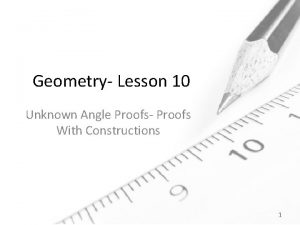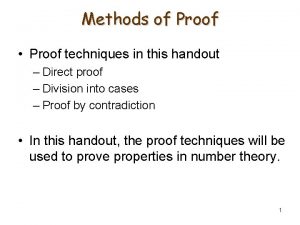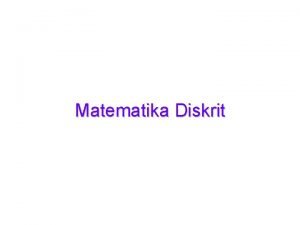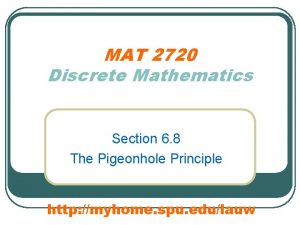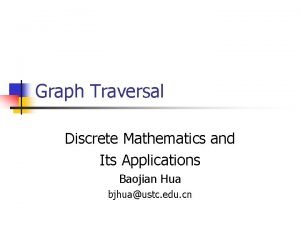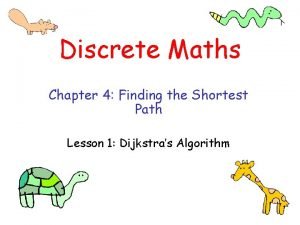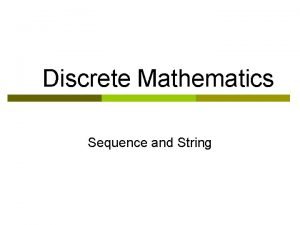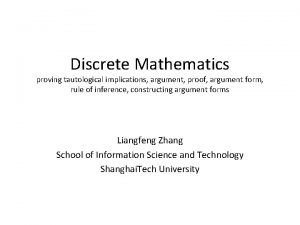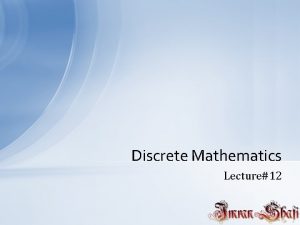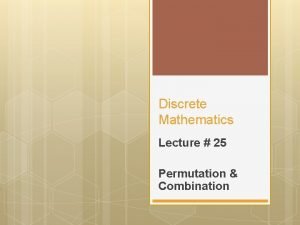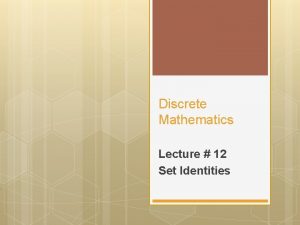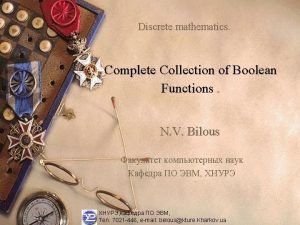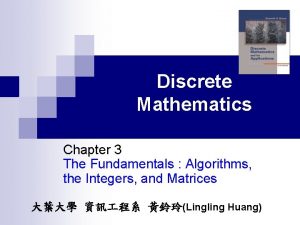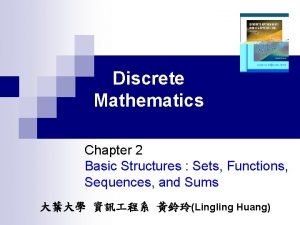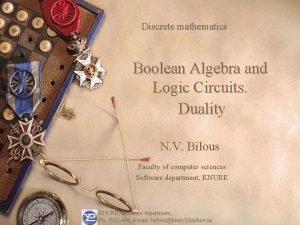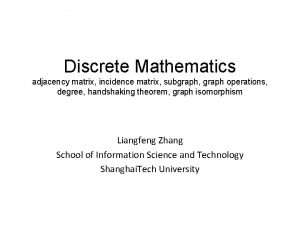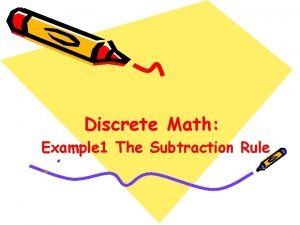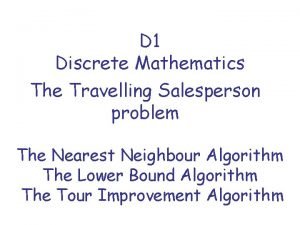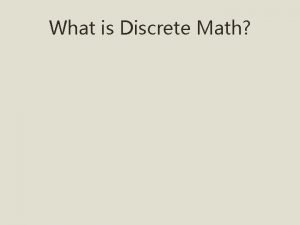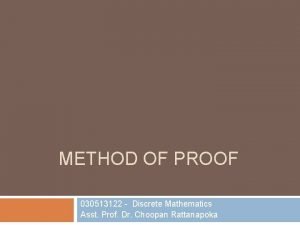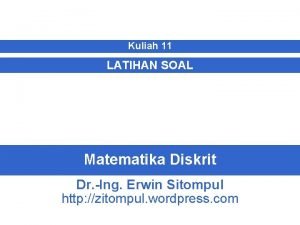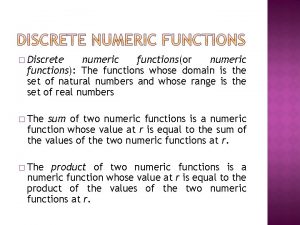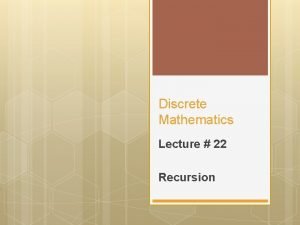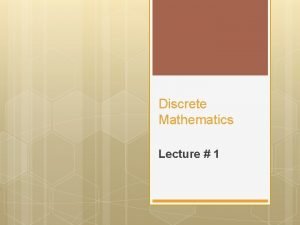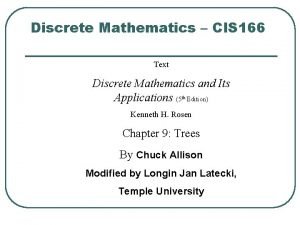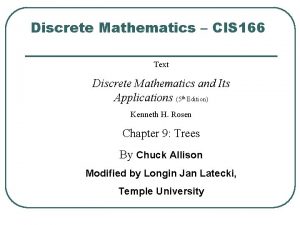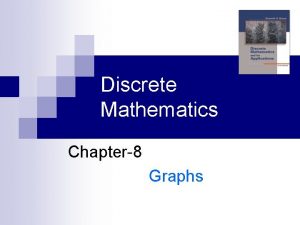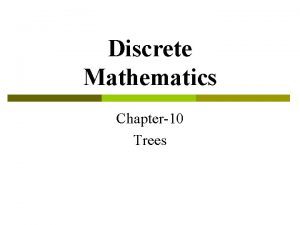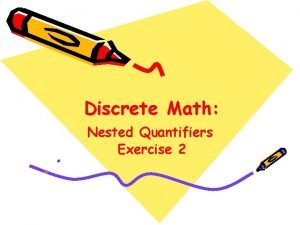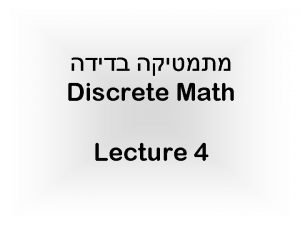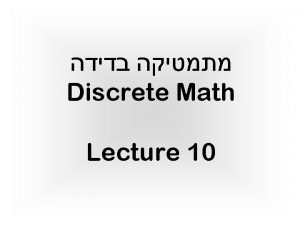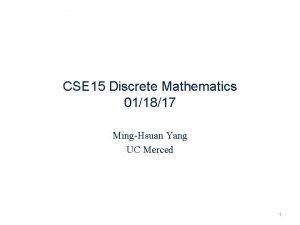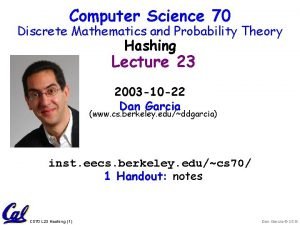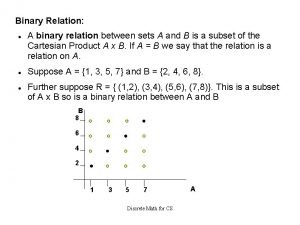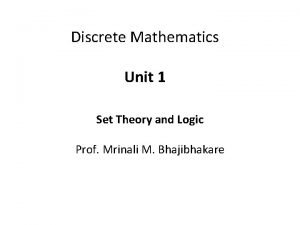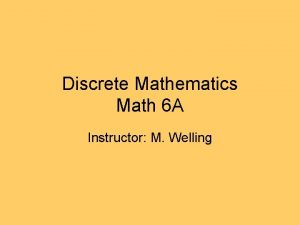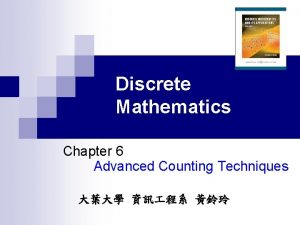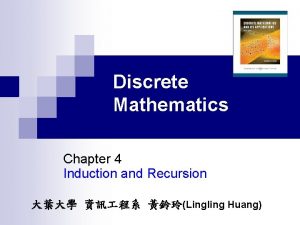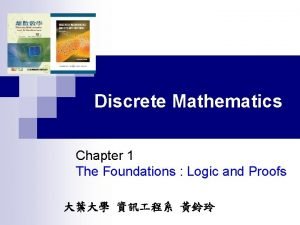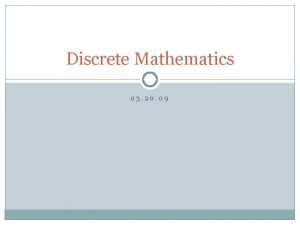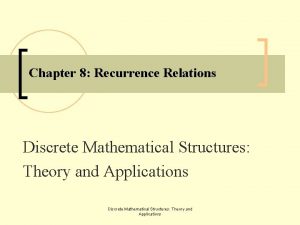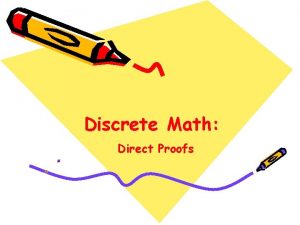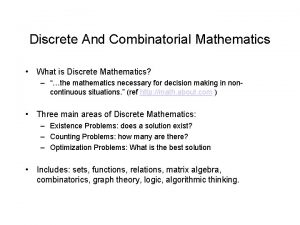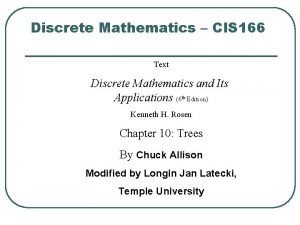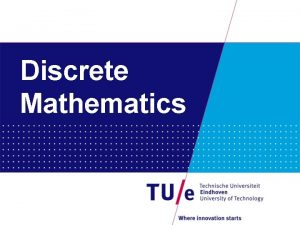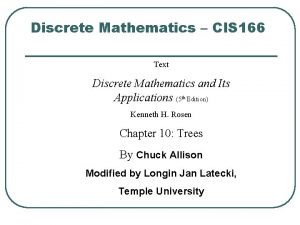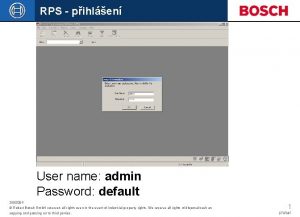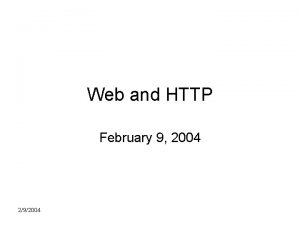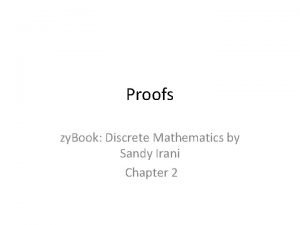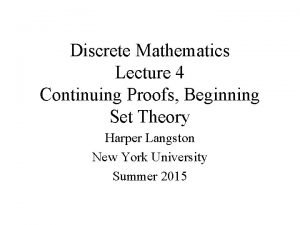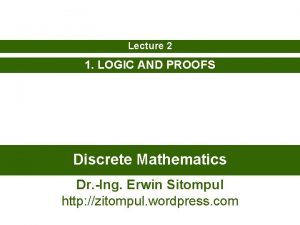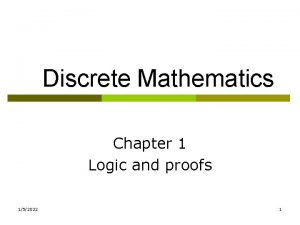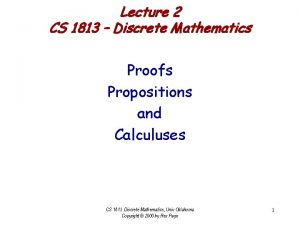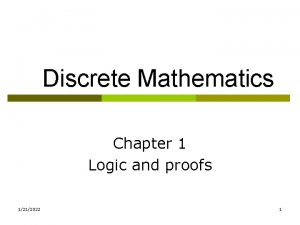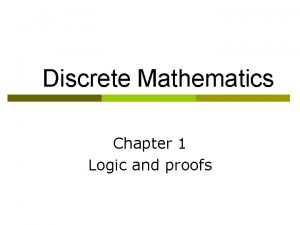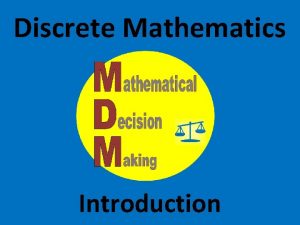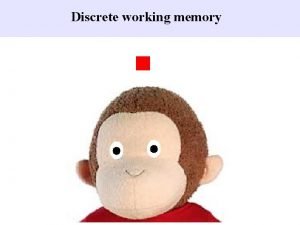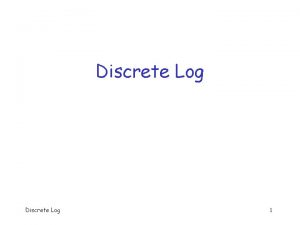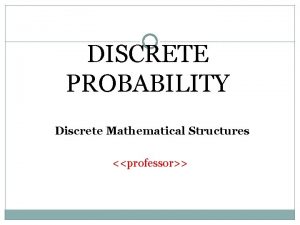Introduction to Proofs 292004 Discrete Mathematics for Teachers















































- Slides: 47

Introduction to Proofs 2/9/2004 Discrete Mathematics for Teachers, UT Math 504, Lecture 05

Background • The rules of chess define the game. You consult them to determine what moves are legal and whether a position ends in a win for White, a win for Black, or a draw. At the same time they tell you nothing about how to play chess. They determine which moves are legal but not which moves are good, which tactics indispensable, which strategies effective, and which moves beautiful. They identify winning positions but offer no plans for reaching them. New players must learn the rules until they become second nature and follow them unfailingly, but the players’ judgment and creativity, honed by diligent study, lead to beautiful victories. 2/9/2004 Discrete Mathematics for Teachers, UT Math 504, Lecture 05 2

Background • Propositional logic provides the rules for proving mathematical truths. They determine whether inference is legitimate but not whether it is useful, effective, or beautify. They identify valid arguments but offer no plans formulating them. New mathematicians must learn the rules until they become second nature and follow them unfailingly, but the mathematicians’ judgment and creativity, honed by diligent study, lead to beautiful proofs. 2/9/2004 Discrete Mathematics for Teachers, UT Math 504, Lecture 05 3

Background • We are almost ready to cutting our teeth on some theorems and proofs. The remaining preliminary is a brief discussion of the predicate calculus. Most theorems are not statements about 2 is even”) but rather claims that certain individual cases (like “ 4 propositions hold universally (like “the square of every even number is even”) or statements about existence or non existence of cases (like “every integer over 1 has a prime factor” or “there is no largest prime number”). The predicate calculus teaches us how to handle such universal and existential claims. • Once we get past the predicate calculus, we will start writing proofs. We will begin with a number of standard approaches to proofs, followed by careful examination of the particular proof technique called mathematical induction. 2/9/2004 Discrete Mathematics for Teachers, UT Math 504, Lecture 05 4

The Predicate Calculus • A formula is an arithmetic expression with variables in it. We can assign values to (instantiate) the variables from some agreed upon set of allowable numbers. Once we do so the formula becomes a number. For instance the formula x+3 is not a number, but as soon as we instantiate x by setting x=5, for instance, the formula becomes the number 8. A formula is, in fact, a function from some domain of numbers into some codomain of numbers. 2/9/2004 Discrete Mathematics for Teachers, UT Math 504, Lecture 05 5

The Predicate Calculus • A predicate is an English expression in the form of a proposition but with variables in it. We can instantiate the variables from some agreed upon set of possible values (called the universe of discourse or the domain of discourse). Once we do so, the predicate becomes a proposition. For instance suppose we consider the statement, “x is a University of Tennessee mathematics professor, ” where the universe of discourse for x is the set of people currently living in the world. This statement is a predicate. It has no truth value as long as x remains a variable. If we instantiate x, however, by setting x=Reid Davis, then the predicate becomes a proposition with a truth value. A predicate is, in fact, a function from the universe of discourse (domain) into some codomain of propositions. 2/9/2004 Discrete Mathematics for Teachers, UT Math 504, Lecture 05 6

The Predicate Calculus • In fact, the term propositional function is a synonym for predicate (it is a function that yields propositions, just like a complex function yields complex numbers, a rational function yields rational numbers, etc. ). We can denote a predicate using function notation, for instance defining P(x)= “x is a University of Tennessee mathematics professor. ” The P(Reid Davis) is true, and P(Queen Elizabeth II) is false. 2/9/2004 Discrete Mathematics for Teachers, UT Math 504, Lecture 05 7

The Predicate Calculus • Predicates can have more variables. For instance we can form the predicate P(x, y)=“x is y years old” where the universe of discourse for x is living people and for y is nonnegative integers. Then P(Reid Davis, 29) is the false proposition, “Reid Davis is 29 years old. ” 2/9/2004 Discrete Mathematics for Teachers, UT Math 504, Lecture 05 8

The Predicate Calculus Consider the predicate P(x)=“the square of x is nonnegative” where the universe of discourse for x is the set of real numbers. we can produce propositions by instantiating x. For instance, P(5) is the true proposition, “the square of 5 is nonnegative. ” There are infinitely many choices for x and thus infinitely many different propositions P(x). They are, however, all true. Thus the statement “for every value of x, the proposition P(x) is true” is a true proposition. This illustrates another way to turn a predicate into a proposition: We assert the truth of the proposition for all values of the variable. This is one way of quantifying a variable. 2/9/2004 Discrete Mathematics for Teachers, UT Math 504, Lecture 05 9

The Predicate Calculus • There are only two quantifiers in common mathematical usage. The one we just discussed is the universal quantifier, which asserts the truth of a predicate for every value of a variable. The notation for universal quantification is ∀, an upside down and backwards A. Thus one writes ∀x P(x), which is read, “for all x, P(x)” or “for every x, P(x). ” For instance one might write, ∀x the square of x is nonnegative, which is read, “for all x, the square x is nonnegative” or “the square of every x is nonnegative” or even “the square of every real x is nonnegative” (specifying the universe of discourse). 2/9/2004 Discrete Mathematics for Teachers, UT Math 504, Lecture 05 10

The Predicate Calculus • The other common quantifier is the existential quantifier, which asserts the existence of a value of the variable that makes the predicate true. The notation for universal quantification is ∃, an upside down and backwards E. One writes ∃x P(x), which is read, “there exists an x such that P(x)” or “for some x, P(x). ” For instance one might write, ∃x the number x is even and prime, with the universe of discourse for x being the positive integers. One reads this, “there exists an x such that the number x is even and prime” or “some positive integer x is even and prime. ” This proposition is true since there is at least one value of x (namely x=2) that make the predicate true. 2/9/2004 Discrete Mathematics for Teachers, UT Math 504, Lecture 05 11

The Predicate Calculus • A predicate becomes a proposition as soon as we instantiate or quantify each of its variables. For instance, let P(x, y, z) be the predicate x+y=z where the universe of discourse for all three variables is the integers. Then for instance ∀x ∀y P(x, y, 3) is the false proposition, “for every x and every y, x+y=3” We can disprove a universally quantified proposition by finding a single instantiation that makes the predicate false. In this case P(2, 4, 3) asserts 2+4=3, which is false. 2/9/2004 Discrete Mathematics for Teachers, UT Math 504, Lecture 05 12

The Predicate Calculus • Similarly we can prove an existentially quantified proposition by finding a single instantiation that makes the predicate true. With P(x, y, z)=“x+y=z”, the proposition ∃x ∃y P(x, y, 3) states, “There are values of x and y for which x+y=3. ” This is true since P(1, 2, 3) is true. • Order of quantification does not matter as long as all quantifiers are of the same type (all universal or all existential). For instance ∀x ∀y and ∀y ∀x produce the same proposition, as do ∃x ∃y and ∃y ∃x. If we mix universal and existential quantifiers, however, then the order is crucial. For instance ∀x ∃y y>x says, “for every x there exists a y such that y>x. ” In other words, no matter what number we choose, there is a larger number. This is true since, for instance, we can always use y=x+1. 2/9/2004 Discrete Mathematics for Teachers, UT Math 504, Lecture 05 13

The Predicate Calculus • On the other hand, ∃x ∀y y>x says, “there is an x such that for every y it is the case that y>x. ” In other words there is a single x that is smaller than every y. ” This is plainly false since regardless of what x we choose, the value y=x− 1 will be smaller. It is sometimes difficult to read propositions correctly when they have mixed quantifiers, so always approach such problems carefully. 2/9/2004 Discrete Mathematics for Teachers, UT Math 504, Lecture 05 14

The Predicate Calculus • Negating a universally quantified predicate is logically equivalent to existentially quantifying the negated predicate. That is ~∀x P(x) ≡ ∃x ~P(x). Almost any example makes this obvious. For instance saying, “it is not that case that every prime is odd” is equivalent to saying, “there is a prime that is not odd. ” 2/9/2004 Discrete Mathematics for Teachers, UT Math 504, Lecture 05 15

The Predicate Calculus • Negating an existentially quantified predicate is logically equivalent to universally quantifying the negated predicate. That is ~∃x P(x) ≡ ∀x ~P(x). This is also obvious from an example. For instance, “there is no prime number that is the largest prime, ” is clearly equivalent to, “every prime number is not the largest prime. ” 2/9/2004 Discrete Mathematics for Teachers, UT Math 504, Lecture 05 16

The Predicate Calculus • This rule also works for multiple quantifiers. The simple rule is that when a negation “passes through” a quantifier, the quantifier changes to the other quantifier. For instance (in an abbreviated notation) ~∀∃∀ ≡ ∃~∃∀ ≡ ∃∀~∀ ≡ ∃∀∃~. Again, it is very easy to make mistakes when negating multiply quantified propositions, so pay close attention when doing so. 2/9/2004 Discrete Mathematics for Teachers, UT Math 504, Lecture 05 17

The Predicate Calculus • The exposition on page 100– 101 is hard to follow. In the next few slides below I try to explain how the ideas from those pages appear in practical proof writing 2/9/2004 Discrete Mathematics for Teachers, UT Math 504, Lecture 05 18

The Predicate Calculus • Most mathematical theorems are universally quantified propositions, even if they do not seem to have that form. For instance theorem “the sum of two even integers is even” is really the proposition ∀x ∀y if x and y are even, then x+y is even, where the universe of discourse is the integers. Students first learning to read mathematics sometimes miss this fact. 2/9/2004 Discrete Mathematics for Teachers, UT Math 504, Lecture 05 19

The Predicate Calculus • More troublesome to novice proof writers is the task of proving universally quantified propositions. When the variables can take on infinitely many values, how can we address infinitely many cases in a finite proof? For instance suppose we want to prove the sum of even integers is even, as we mentioned above. Students will often start correctly by saying, “Let x and y be even integers. ” Then they are stumped because they do not know how to let x and y be all the even integers at once. They will not “hold still” so that we can work with them. 2/9/2004 Discrete Mathematics for Teachers, UT Math 504, Lecture 05 20

The Predicate Calculus • Here is a proof of the proposition. Let x and y be even integers. The definition of even says that an integer is even if it is twice another integer. Since x and y are even, there exist integers m and n such that x=2 m and y=2 n. Thus x+y=2 m+2 n=2(m+n). Since m+n is an integer, and x+y=2(m+n), then x+y is even. 2/9/2004 Discrete Mathematics for Teachers, UT Math 504, Lecture 05 21

The Predicate Calculus • The key is that x and y do not represent all the even integers. Rather, x and y are unknown but fixed even integers. It is as though we ask a friend to choose two even integers arbitrarily and call one x and one y but without telling us what the numbers are. We now operate on x and y “blindfolded. ” That is, we operate on them in ways that are mathematically correct even though we do not know what they are. Since we know only that they are even integers, we are safe as long as we depend only on properties common to even integers (such as being two times other integers). The argument works regardless of which even integers x and y are, so it is, in fact, true for all even integers x and y. 2/9/2004 Discrete Mathematics for Teachers, UT Math 504, Lecture 05 22

The Predicate Calculus • More generally, to prove that a predicate is true for all values of its variables, we commonly start by letting the variables be unknown but fixed members of the universe of discourse. We do not know what they are, but we can count on them to have the properties common to all elements of the universe of discourse (and we cannot count on them to have other properties). If we can prove the result for these arbitrary members, then it is true for all members because it depends only on properties that all members have. That is, if we had chosen other members, the proof would work for them as well. 2/9/2004 Discrete Mathematics for Teachers, UT Math 504, Lecture 05 23

The Predicate Calculus • Using universally quantified propositions: If we know that a universally quantified proposition is true, then we may freely count on the truth of the predicate for particular values of its variables. This is nearly trivial, but students sometimes miss it in the heat of battle. For instance, in the proof above we assumed x and y were even. Since all even integers are twice other integers, then in particular the even integers x and y are twice other integers. We can use this fact despite not knowing what x and y are. 2/9/2004 Discrete Mathematics for Teachers, UT Math 504, Lecture 05 24

The Predicate Calculus • To prove an existentially quantified proposition, we merely have to find one set of values that makes the predicate true. For instance to prove “there exists an even prime number” we merely have to note that 2 is an even prime. In the proof that the sum of even integers is even, we had to show the existence of an integer z such that x+y=2 z (in our proof z=m+n). Of course some such examples are tremendously hard to come by. There are, for instance, functions that are continuous nowhere and continuous functions that are differentiable nowhere. We might be hard pressed to construct such examples. 2/9/2004 Discrete Mathematics for Teachers, UT Math 504, Lecture 05 25

The Predicate Calculus • Most often, however, existence proofs result from the attempt to find counterexamples to disprove universally quantified propositions. That is, someone asserts ∀x P(x). You believe it is false, so you undertake to prove ~∀x P(x). This is equivalent to proving ∃x ~P(x). An example that proves the latter proposition is called a counterexample. It disproves ∀x P(x). For instance, to disprove the proposition “all prime numbers are odd” we merely need cite the existence of the even prime number 2. 2/9/2004 Discrete Mathematics for Teachers, UT Math 504, Lecture 05 26

The Predicate Calculus • Using existentially quantified propositions: When we know an existentially quantified proposition is true, we are entitled to name and use a value (or values) of the predicate’s variables that make the predicate true, even if we do not know what the value(s) are. For example, in the proof that the sum of even integers is even, we had even integers x and y. Their evenness guarantees the existence of numbers that, when doubled, equal x and y. Since those numbers exist, we named them m and n, saying x=2 m and y=2 n. If we know they exist, we may name them and use them. 2/9/2004 Discrete Mathematics for Teachers, UT Math 504, Lecture 05 27

The Predicate Calculus • On pp. 101– 103 the book tries to introduce a method for drawing Venn Diagrams to analyze the truth of quantified propositions. I do not find the notions there helpful, but perhaps they will serve you better. You do not have to read them, but it might be worth your time to look them over briefly to see if they click with you. 2/9/2004 Discrete Mathematics for Teachers, UT Math 504, Lecture 05 28

Introductory theorems and proofs about integers • Section 3. 2 introduces axioms about the integers and uses them to prove basic theorems about the integers. On page 106 the book shows an example of a painfully careful formal two column proof of a simple result. This example shows that such rigorous argument and justification is possible but is far too pedantic for most purposes. The informal proof of the same result in Theorem 3. 6 at the bottom of page 106 is just as sound but far easier to read, trusting the reader’s ability to fill in many of the trivial steps. 2/9/2004 Discrete Mathematics for Teachers, UT Math 504, Lecture 05 29

Introductory theorems and proofs about integers • This illustrates an often overlooked aspect of the nature of proofs. Mathematicians write proofs in English (or Finnish or whatever language is appropriate). Mathematical notation, however fancy and useful, is simply shorthand for words. Mathematics dictates the logic of your proof, but the usual rules of English composition guide your explanation of it: Use complete sentences and standard punctuation. Strive for clarity, economy, and beauty. Write in a fashion suited to your intended audience, giving more or fewer details according to the need of your readers. 2/9/2004 Discrete Mathematics for Teachers, UT Math 504, Lecture 05 30

Introductory theorems and proofs about integers • Taxonomy of proofs: Most theorems take the form p→q, usually with some quantification. Most proofs of such an implication fall into one of three categories. 2/9/2004 Discrete Mathematics for Teachers, UT Math 504, Lecture 05 31

Introductory theorems and proofs about integers • Direct Proof: Assume p is true and show q follows unavoidably. [Since q is true whenever p is true, the implication p→q is true. ] • Proof by Contrapositive: Since the contrapositive ~q→~p is logically equivalent to the original implication, assume ~q is true and show that ~p follows unavoidably. • Proof by Contradiction: Assume p and ~q are both true and derive a contradiction. [The only way a true implication can have a false conclusion (the contradiction) is for the antecedent (p⋀~q) to be false. This rules out the only case in which p→q is false, so it must be true. ] 2/9/2004 Discrete Mathematics for Teachers, UT Math 504, Lecture 05 32

Introductory theorems and proofs about integers • Sometimes in a direct proof we partition up the ways that p can be true and show separately for each block of the partition that p→q. This is called a proof by cases. • Proofs by contrapositive and contradiction are both called indirect proofs. 2/9/2004 Discrete Mathematics for Teachers, UT Math 504, Lecture 05 33

Introductory theorems and proofs about integers • Theorem 3. 8 a: For each integer a we have a∙ 0=0. Proof: (Direct Proof) Let a be an integer. Note that a+a∙ 0=a∙ 1 + a∙ 0=a(1+0)=a∙ 1=a. That is, we added a∙ 0 to a and got a back. So a∙ 0 is an additive identity for a. However we also know that a+0=a. Therefore a+a∙ 0=a+0. Adding –a to both sides of this equation yields –a+a+a∙ 0=–a+a+0, so 0+a∙ 0=0+0, and a∙ 0=0. 2/9/2004 Discrete Mathematics for Teachers, UT Math 504, Lecture 05 34

Introductory theorems and proofs about integers • In this proof, why do I not simply argue a∙ 0=a∙(1– 1)=a∙ 1–a∙ 1=a– a=0? The answer is that I do not know a∙(– 1)=–a. That is, I do not know that the product of a with the additive inverse of 1 yields the additive inverse of a. That result happens to be true, but it is not an axiom and I have not proved it yet. Therefore I cannot use it. Be careful in this section to use only the axioms and theorems of the section to prove your results. Pay special attention in writing up results about positive and negative numbers since the definition of positive is not what you might expect. Much of what you know is normally true of positive and negative numbers requires proof in this section. 2/9/2004 Discrete Mathematics for Teachers, UT Math 504, Lecture 05 35

Introductory theorems and proofs about integers • Theorem 3. 7: If n 2 is even, then n is even. This is a nice example of a proof by contrapositive, and book does a nice job with it. • Theorem 3. 10 a: For integers a and b it always holds that (a≥b)⋀(b≥a)→(a=b). The book gives a nice example of proving this result by contradiction. • Theorem 3. 12: If n is an integer, then n 2≥ 0. This is a proof by cases. Since n is an integer, it must be positive, negative, or 0. In each case it is easy to show that n 2≥ 0. 2/9/2004 Discrete Mathematics for Teachers, UT Math 504, Lecture 05 36

Introductory theorems and proofs about integers • In some axiomatic systems all true propositions are provable. That is, all true propositions are potential theorems (recall that a theorem is a proposition that has been proved true). The famous Gödel Incompleteness Theorem demonstrates, however, that in any mathematical system that includes the integers with standards arithmetic there are true statements that are not provable and false statements that are not disprovable. In this sense every consistent system that allows for standard arithmetic is incomplete. 2/9/2004 Discrete Mathematics for Teachers, UT Math 504, Lecture 05 37

Mathematical induction • Frequently we want to prove a proposition of the form ∀n P(n), in which the universe of discourse is the set of positive integers. Mathematical induction is a tool particularly well suited to the proof of such propositions. The principal of mathematical induction seems highly intuitive, but it turns out not to follow from the other axioms about the positive integers. We must take it as an axiom. There are three equivalent statements of the principle of mathematical induction, though the equivalence is not obvious. 2/9/2004 Discrete Mathematics for Teachers, UT Math 504, Lecture 05 38

Mathematical induction • Principle of Mathematical Induction (weak induction): Suppose that P(1) is true and that for every positive integer n, if P(n) is true then P(n+1) is true as well. Then for every positive integer n, the proposition P(n) is true. • Principle of Mathematical Induction (strong induction): Suppose that P(1) is true and that for every positive integer n, if P(1), P(2), …, and P(n) are true then P(n+1) is true as well. Then for every positive integer n, the proposition P(n) is true. • Well Ordering Principle: Every nonempty set of positive integers has a least element. 2/9/2004 Discrete Mathematics for Teachers, UT Math 504, Lecture 05 39

Mathematical induction • Pedagogical note: All three of these forms are useful, but the first is by far the most common. The book uses two variables in the statement of weak induction, saying if P(1) is true and P(k)→P(k+1) is true for all k, then P(n) is true for all n. This is a well intentioned attempt to make induction clear to students seeing it for the first time, but I think it generates more confusion than clarity. Mathematicians typically stick with a single variable as I have done, and I think that approach is clearer. 2/9/2004 Discrete Mathematics for Teachers, UT Math 504, Lecture 05 40

Mathematical induction • Intuitively the idea of induction is this. I prove P(1). This is called the basis step. Then for a fixed but arbitrary n, I assume P(n) is true and I use it to prove P(n+1). This is called the inductive step, and the assumption that P(n) is true is called the induction hypothesis (sometimes IH for short). Thus P(n)→P(n+1) is always true. Since, P(1) is true, then P(2) is as well. So P(3) is, and thus P(4) is, etc. It is typical to require beginning students to label their basis and inductive steps. With practice, however, mathematicians find that induction proofs are usually mechanical, and they write them quite casually. 2/9/2004 Discrete Mathematics for Teachers, UT Math 504, Lecture 05 41

Mathematical induction • The sum of the first n positive odd integers is n 2. That is, for all positive integers, 1+3+…+(2 n– 1)=n 2. (1) Proof: Basis Step: If n=1, the proposition states that 1=12, which is true. (2) Inductive Step: For some positive integer n, assume the proposition holds. That is, assume 1+3+…+ (2 n– 1) = n 2. We want to show that it also holds for n+1. That is, we want to show 1+3+…+(2 n– 1)+(2 n+1)=(n+1)2. Using the induction hypothesis we see [1+3+…+(2 n– 1)] + (2 n+1) = n 2 + (2 n+1) = (n+1)2. By the principle of mathematical induction, 1+3+…+(2 n– 1)=n 2 for all positive integers n. 2/9/2004 Discrete Mathematics for Teachers, UT Math 504, Lecture 05 42

Mathematical induction • Examples 3. 14 and 3. 15 in the book are quite similar to the previous theorem and proof, but the book gives them in elaborate detail. You can judge for yourself whether my briefer approach above or the book’s longer approach is clearer. 2/9/2004 Discrete Mathematics for Teachers, UT Math 504, Lecture 05 43

Mathematical induction • Example 3. 16: If n is a positive integer, then n 3–n is a multiple of 3. (1) Proof: Basis Step: If n=1, then we have 13– 1=0=3∙ 0, which is a multiple of 3. (2) Inductive Step: For some positive integer n, assume n 3–n is a multiple of 3. So, for instance, n 3–n=3 m, for some integer m. We wish to show (n+1)3 (n+1) is a multiple of 3. But (n+1)3 (n+1)=(n 3+3 n 2+3 n+1)–(n+1) =(n 3–n)+ 3 n 2+3 n=3 m+3 n 2+3 n=3(m+n 2+n), which is a multiple of 3. Therefore by the principle of mathematical induction, for all positive integers n, it holds that n 3–n is a multiple of 3. 2/9/2004 Discrete Mathematics for Teachers, UT Math 504, Lecture 05 44

Mathematical induction • By the way, there is nothing magic about showing the basis step is true for the variable equal to 1. If one has P(0) for the basis step, then the proof shows P(n) holds for all nonnegative n. If the basis step is P(5), then theorem holds for all n≥ 5. Example 3. 23 shows an induction in which P(n) holds for all n≥ 4. 2/9/2004 Discrete Mathematics for Teachers, UT Math 504, Lecture 05 45

Mathematical induction • Sometimes the principle of strong induction seems easier to use. It allows you to assume all prior cases in the inductive step. Intuitively this is a stronger assumption that in weak induction, but in fact the two sets of assumptions are equivalent. 2/9/2004 Discrete Mathematics for Teachers, UT Math 504, Lecture 05 46

Mathematical induction • Theorem: Every positive integer greater than 1 has a prime factor. • (1) Basis Step: The positive integer 2 has itself for a prime factor. • (2) Inductive Step: For some positive integer n, suppose integers 2, 3, 4, …, n all have prime factors. We want to show that n+1 has a prime factor. Let us consider two cases: If n+1 is prime, then it is a prime factor of itself. If n+1 is not prime, it has factors a and b such that n+1=ab. Necessarily a and b are smaller than n+1. Therefore by the induction hypothesis a has a prime factor, say p. Then n+1=ab. But p is a factor of a and therefore of ab, so n+1 has a prime factor. By the principle of mathematical induction, every positive integers greater than 1 has a prime factor. 2/9/2004 Discrete Mathematics for Teachers, UT Math 504, Lecture 05 47
 Lesson 10 unknown angle proofs-proofs with constructions
Lesson 10 unknown angle proofs-proofs with constructions Lesson 9 unknown angle proofs
Lesson 9 unknown angle proofs Methods of proof
Methods of proof Kenneth rosen discrete mathematics pdf
Kenneth rosen discrete mathematics pdf Pigeonhole principle in discrete mathematics
Pigeonhole principle in discrete mathematics What are ps and qs
What are ps and qs Equivalence statement definition
Equivalence statement definition Tree traversal in discrete mathematics
Tree traversal in discrete mathematics Find shortest path
Find shortest path Sequence of strings
Sequence of strings Tautological implications
Tautological implications Transitive relation
Transitive relation Propositional logic puzzles
Propositional logic puzzles Permutation and combination in discrete mathematics
Permutation and combination in discrete mathematics Set identities table
Set identities table Boolean functions in discrete mathematics
Boolean functions in discrete mathematics Advanced counting techniques
Advanced counting techniques The value of 52003 mod 7 is?
The value of 52003 mod 7 is? Onto function definition
Onto function definition In triangle pqr
In triangle pqr Duality in discrete mathematics
Duality in discrete mathematics Incidence matrix in discrete mathematics
Incidence matrix in discrete mathematics Subtraction rule counting
Subtraction rule counting Travelling salesman problem discrete mathematics
Travelling salesman problem discrete mathematics Discrete mathematics
Discrete mathematics Pqqpq
Pqqpq Discrete math questions
Discrete math questions Discrete numeric function is defined as
Discrete numeric function is defined as Recursive definition of odd positive integers
Recursive definition of odd positive integers Compound statement symbols
Compound statement symbols M ary tree in discrete mathematics
M ary tree in discrete mathematics M ary tree in discrete mathematics
M ary tree in discrete mathematics Working memory graphs
Working memory graphs What is rooted tree in discrete mathematics
What is rooted tree in discrete mathematics Quantifiers discrete mathematics exercises
Quantifiers discrete mathematics exercises What does onto mean in discrete math
What does onto mean in discrete math Binary relation in sets
Binary relation in sets Cse 15
Cse 15 Computer science 70
Computer science 70 Binary relation in discrete mathematics
Binary relation in discrete mathematics Discrete math set theory
Discrete math set theory Proposition in discrete mathematics
Proposition in discrete mathematics Inverse relations
Inverse relations Advanced counting
Advanced counting Induction and recursion discrete mathematics
Induction and recursion discrete mathematics Discrete mathematics chapter 1
Discrete mathematics chapter 1 Division algorithm in discrete mathematics
Division algorithm in discrete mathematics Recurrence relation in discrete mathematics
Recurrence relation in discrete mathematics
